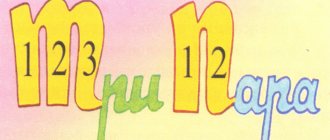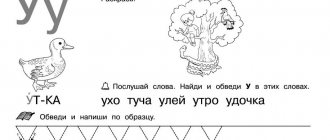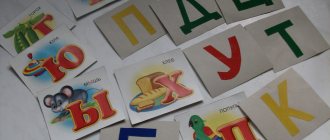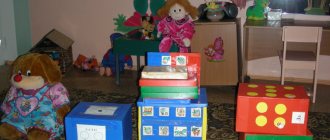Otroshko G.V., teacher-speech therapist of mixed orphanage No. 1, Yaroslavl
Mixing the letters sh and sh in children's written works and when reading occurs very often. Firstly, it can be classified as a phonemic group, since the sounds [ш] and [ш] are similar in acoustic characteristics, or articulatory - the articulomes of these sounds are also similar. Secondly, this confusion can be qualified as optical, since the graphemes sh and sh are also similar (both handwritten and printed versions). Thirdly, such mixing can be considered kinetic. In children with mental retardation, not only unformed phonemic perception is noted, but also a deficiency of visual gnosis and subtle differentiation of hand movements. It is difficult for children to correctly read the syllables she, shi, she, which are often read as shche, shchi, shche. Therefore, when working on differentiating the letters sh and sh, it is necessary to take into account all the child’s problems and approach this problem comprehensively. Comprehensive work on differentiating the confusion between w and shch makes it possible to obtain stable results and reduce the number of errors made by children with mental retardation in writing and reading. The tasks used contribute to the development of phonemic processes, visual gnosis, and motor components. Tasks and exercises Clarifying the pronunciation of the sounds sh and shch Pronunciation is clarified first separately, then differentiated. Children's attention is drawn to the acoustic signs of sounds and articulatory patterns. Forming an idea of the phonemes [ш] and [ш] Children look at pictures, name them, come up with words, sentences and stories from words with each of these sounds, work at the levels of phrase and text. Working with contour pictures is interesting for children. Coloring exercises are useful, as they help to engage hand motor skills (Fig. 1, 2).
- Name the objects whose names contain the sound [w].
- Color only objects whose names contain the sound [w].
- Name the objects whose names contain the sound [у].
- Paint only objects whose names contain the sound [у].
Differentiation of phonemes [ш] and [ш] Children at the level of isolated pronunciation of syllables, words, phrases, texts learn to distinguish sounds by ear. Work is being done with contour pictures (Fig. 3, 4).
- Color and name only the pictures whose names contain the sound [w].
- Connect the pictures with the letter w (the letter is written at the top of the picture).
- Color and name only the pictures whose names contain the sound [у].
- Match the pictures with the letter sh and sh.
- Cut out and glue pictures with letters onto two trays (on two shelves, in two circles, etc.). Come up with a sentence that would contain 2-3 names of objects from the picture, etc.
Examination of the letters Ш and Ш Children consider the letters first separately, then differentiated. The element-by-element structure of each letter, their similarities and differences are clarified. Match the letter with the images and paint them with two colors (Fig. 5). Children also sculpt letters from plasticine, make them from wire, correlate printed and written letters, look for a letter by touch in the “Wonderful Bag”, and practice finding the letters w and sh in a story picture (Fig. 6).
- Find the letters and color them with the corresponding pencils.
differentiated search for letters Ш and Ш
- Mark the letters sh and sh in different colors and establish the patterns of their location.
w w w w w w w w w w w w w w w w w w w w w w w w w w w w w w w w w w w w w w w sh sh sh sh sh sh sh sh sh sh sh sh sh sh sh sh sh sh sh sh sh sh sh sh sh sh sh
- Mark the letters sh, shch, ch, c with different pencils.
ts ch u ch n n p ch n lu h ts sh c i sch y p sch w and y q s sh q p sh y and h cl ch w q sch q nc q s sch p ts u ch u ch u shp ts w s ch s s s s s s s s s s s s s s s s s s s s s s s s s s sch z w g w sh sh n pu ts sh p sch n sch z n w w sch sh n pi sch sh m ts l ch p i ch sh m l sh p c sh i sh t ch i l l l k ch c i p ts l m sh c sh m i c m sh l h sh w u i sh m l c c h sch q q q q q q q q q q q q q q q q q q q q q q q q q q q q q q q q q q ch c ch m c p sh ch sh c ch c sch c ch Differentiated spelling of letters sh and sch
- Write letters on each other's palms, on each other's backs, and guess which letter is written (dermalexy technique).
- Write rows of letters and find patterns in their arrangement.
- Continue stitching with pencils of matching colors.
w w w w w w w w w w w w w w w w w w w w w w w w w Reading syllables with the letters sh, shch
- Read the syllables in pairs, lines, columns.
sha-scha sho-scho shu-schu ash-ash osh-osh ush-ush shi-schi she-sche sho-scho ish-isch es-esch-esch Reading and writing the letters sh and sch in words
- Read the words in pairs, columns, columns in pairs, lines.
- Find the words in the rows by highlighting the letters w and y with different pencils.
brushesgoodsqueakpike drag fluffygrovetopreedsmouse thing skinnythickbucketchershaprotectiontentaclesfingersbagstitched porridgeheadfinchbroochpotatoprotective alarmedcrushedshieldcartilage
- Write “letter dictations”, writing the letters w and sch into the diagrams of the words read, indicating their position in relation to the beginning, middle, and end of the word.
- Write the words with w and shch in two columns.
..uka ..elchok jug..in pry..ik bro..ka cro..it ..orokh ..epka ..epotka pi..it ka..a pla.. mountain..ina gr..u turn..at..elk for..itnik ver..ina Transformation of words, selection of part of a word from two offered
- Add the suffix -ish to the words. What words will you get?
fur coat - ... hat - ... hut - ... curtain - ... washer - ... pencil - ... mop - ... cloak - ... tick - ...
- In these words, replace the first letter with the letter sh or sh. What words will you get?
slipper - ... cup - ... aunt - ... T-shirt - ... disputes - ... sorry - ... flank - ... slept - ... kid - ... wreath - ... bear - ... coil - ... stranded - ... tick - ... river - ... hand - ...
- Add the syllables she or shche to the words. Write the words in two columns.
Miracles.., ray.., taught.., canvases.., ti.., voice.., beautiful.., you.., treasure.., kept.. .
- Add the syllables chic or shchik to the words. Write the words in two columns.
Dances.., winters.., karanda.., set.., shala.., treasures..., cleaning.., close.., watches.. . Working with a proposal
- Make up sentences. Write them down.
looking for things, detective, Skinny, ours, missing. carefully, I eat food well, and I need to chew it. grove, in, The best, sorrel, ours. squeaks, Tiny, box, in, puppy, Ball.
- Fill in the missing words and syllables shi or cabbage soup.
We ate … . Sour… it’s amazing how good..! There's an empty puppy in my... place. Our..x..tniks have strong..you and good..swords. working with short text
- Unravel the riddles of the letters sh and sh.
All the words have changed, the letters are mixed up. You and I read the words, Sh and sh unraveled them. The forest is dense behind the river - ... (bowl). There is a vase in the museum - ... (thicket). We heard loudly - ... (silk)! It exploded... (click). Splashing in the river... (Shurenok). Shura’s mother is calling... (little puppy). I forgive... (I will forgive) And you myself... (I ask).
- Fill in the missing syllables shi or cabbage soup.
Tina! Not Shur..te, we..! Don’t pl.. te le.. and er..! Don’t bother in the quiet of the forest... the chirping of magpies. Hear..those, they sang in the lo..near the ro..tsy of the small... - the nightingales!
- Fill in the missing letters sh and sh. Learn, write from memory.
We..onok Pu..ok St..il flaw..ok, Tooth..brush, P..ena..pot, ..her p..ku, Cha..ku goro..ku, From.. a little bit...a little bit of dust, From a plate...a speck of dust. Ta..it in ..the tree is not in time..and With mi..ki sp..ego ..harp, Ta..it feathers..to ..corner, Ta..it ..sap from the corner. Covered everything with dried crust - A well-off mink!
Setting the sounds “Ш” and “Ш”
Pronouncing the sounds “Ш” and “Ш” seems to be a difficult task for many foreigners learning Russian. However, this task is quite feasible. Practice in front of a mirror. Pay close attention to the position of your tongue and lips. Gradually the sounds will become more and more pure. Sound "Sh"
Move your tongue back and tense the root of your tongue, lift the tip of your tongue towards the alveoli, and stretch out your lips. The sound should resemble a hiss. Like milk running out on the stove or a snake hissing. If the sound is more like a whistle or does not come out at all, do the following. Stretch your lips, move the tip of your tongue towards your upper teeth and pronounce the sound “C”. Pull the sound. Continuing to draw out the sound, slowly move the tip of your tongue towards the alveoli until you make the sound “SH”. Once you “catch” the sound you are looking for, you can reproduce it without difficulty.
Don't be afraid to experiment. Press the tip of your tongue harder against the alveoli (you will feel the sound “stumble” and stop sounding), loosen the pressure, and eventually you will instinctively find the desired position of the articulatory apparatus to produce the sound “Sh”.
Nothing helps in making sounds as well as phonetic exercises. Even if you don’t know the meaning of some words, but know how to read, regular repetition of any words with the syllables SHA, SHO-SHE (read as SHO), SHU, SHI, SHE will be useful .
Hat, chess, miner, checker, mine, puck, scarf.
Chocolate, shock, whisper, silk. Fur coat, joker, joke, noise. Wool, six, rustles. Wide, tire, thorn, rosehip.
Sound "Ш"
Making the sound “Ш” usually takes longer than making the sound “Ш”. In addition, sometimes it is difficult for a foreigner to hear the difference between “Ш” and “Ш”.
So let's start again by observing your articulation. Stretch your lips in a smile (it will be easier this way), move the tip of your tongue closer to your upper teeth, and tense your tongue so that it naturally rises to the roof of your mouth. Try pronouncing the sound "Ш". Remember that it is longer than the "Sh" sound. “Ш” is a soft sound. Keep your lips stretched.
If you make a sound that sounds more like an “F,” that means you are pressing the tip of your tongue against your upper teeth. Lower the tip of your tongue and hide it behind your upper teeth. Tighten your tongue more. Make sure that the sound is born where the tongue tends to touch the palate.
If the sound comes out like a whistle or breathing, extend your lips further into a smile. Tighten your tongue. There should be a feeling that he is trying to “stick” to the sky, but you do not allow him to do this.
If the sound that sounds like an "X" comes out, you have lowered your tongue too low and have overextended it. Relax it, raising it higher towards the sky. If the sound “Sh” comes out, move your tongue forward, closer to the upper teeth.
Once you find the right sound, then it's a matter of practice.
Brush, sliver, bristles, cabbage soup, look, rinse, fistula, sorrel.
LiveInternetLiveInternet
Otroshko G.V., teacher-speech therapist of mixed orphanage No. 1, Yaroslavl
Mixing the letters sh and sh in children's written works and when reading occurs very often. Firstly, it can be classified as a phonemic group, since the sounds [ш] and [ш] are similar in acoustic characteristics, or articulatory - the articulomes of these sounds are also similar. Secondly, this confusion can be qualified as optical, since the graphemes sh and sh are also similar (both handwritten and printed versions). Thirdly, such mixing can be considered kinetic. In children with mental retardation, not only unformed phonemic perception is noted, but also a deficiency of visual gnosis and subtle differentiation of hand movements. It is difficult for children to correctly read the syllables she, shi, she, which are often read as shche, shchi, shche. Therefore, when working on differentiating the letters sh and sh, it is necessary to take into account all the child’s problems and approach this problem comprehensively. Comprehensive work on differentiating the confusion between w and shch makes it possible to obtain stable results and reduce the number of errors made by children with mental retardation in writing and reading. The tasks used contribute to the development of phonemic processes, visual gnosis, and motor components. Tasks and exercises Clarifying the pronunciation of the sounds sh and shch Pronunciation is clarified first separately, then differentiated. Children's attention is drawn to the acoustic signs of sounds and articulatory patterns. Forming an idea of the phonemes [ш] and [ш] Children look at pictures, name them, come up with words, sentences and stories from words with each of these sounds, work at the levels of phrase and text. Working with contour pictures is interesting for children. Coloring exercises are useful, as they help to engage hand motor skills (Fig. 1, 2).
- Name the objects whose names contain the sound [w].
- Color only objects whose names contain the sound [w].
- Name the objects whose names contain the sound [у].
- Paint only objects whose names contain the sound [у].
Differentiation of phonemes [ш] and [ш] Children at the level of isolated pronunciation of syllables, words, phrases, texts learn to distinguish sounds by ear. Work is being done with contour pictures (Fig. 3, 4).
- Color and name only the pictures whose names contain the sound [w].
- Connect the pictures with the letter w (the letter is written at the top of the picture).
- Color and name only the pictures whose names contain the sound [у].
- Match the pictures with the letter sh and sh.
- Cut out and glue pictures with letters onto two trays (on two shelves, in two circles, etc.). Come up with a sentence that would contain 2-3 names of objects from the picture, etc.
Examination of the letters Ш and Ш Children consider the letters first separately, then differentiated. The element-by-element structure of each letter, their similarities and differences are clarified. Match the letter with the images and paint them with two colors (Fig. 5). Children also sculpt letters from plasticine, make them from wire, correlate printed and written letters, look for a letter by touch in the “Wonderful Bag”, and practice finding the letters w and sh in a story picture (Fig. 6).
- Find the letters and color them with the corresponding pencils.
differentiated search for letters Ш and Ш
- Mark the letters sh and sh in different colors and establish the patterns of their location.
w w w w w w w w w w w w w w w w w w w w w w w w w w w w w w w w w w w w w w w sh sh sh sh sh sh sh sh sh sh sh sh sh sh sh sh sh sh sh sh sh sh sh sh sh sh sh
- Mark the letters sh, shch, ch, c with different pencils.
ts ch u ch n n p ch n lu h ts sh c i sch y p sch w and y q s sh q p sh y and h cl ch w q sch q nc q s sch p ts u ch u ch u shp ts w s ch s s s s s s s s s s s s s s s s s s s s s s s s s s sch z w g w sh sh n pu ts sh p sch n sch z n w w sch sh n pi sch sh m ts l ch p i ch sh m l sh p c sh i sh t ch i l l l k ch c i p ts l m sh c sh m i c m sh l h sh w u i sh m l c c h sch q q q q q q q q q q q q q q q q q q q q q q q q q q q q q q q q q q ch c ch m c p sh ch sh c ch c sch c ch Differentiated spelling of letters sh and sch
- Write letters on each other's palms, on each other's backs, and guess which letter is written (dermalexy technique).
- Write rows of letters and find patterns in their arrangement.
- Continue stitching with pencils of matching colors.
w w w w w w w w w w w w w w w w w w w w w w w w w Reading syllables with the letters sh, shch
- Read the syllables in pairs, lines, columns.
sha-scha sho-scho shu-schu ash-ash osh-osh ush-ush shi-schi she-sche sho-scho ish-isch es-esch-esch Reading and writing the letters sh and sch in words
- Read the words in pairs, columns, columns in pairs, lines.
- Find the words in the rows by highlighting the letters w and y with different pencils.
brushesgoodsqueakpike drag fluffygrovetopreedsmouse thing skinnythickbucketchershaprotectiontentaclesfingersbagstitched porridgeheadfinchbroochpotatoprotective alarmedcrushedshieldcartilage
- Write “letter dictations”, writing the letters w and sch into the diagrams of the words read, indicating their position in relation to the beginning, middle, and end of the word.
- Write the words with w and shch in two columns.
..uka ..elchok jug..in pry..ik bro..ka cro..it ..orokh ..epka ..epotka pi..it ka..a pla.. mountain..ina gr..u turn..at..elk for..itnik ver..ina Transformation of words, selection of part of a word from two offered
- Add the suffix -ish to the words. What words will you get?
fur coat - ... hat - ... hut - ... curtain - ... washer - ... pencil - ... mop - ... cloak - ... tick - ...
- In these words, replace the first letter with the letter sh or sh. What words will you get?
slipper - ... cup - ... aunt - ... T-shirt - ... disputes - ... sorry - ... flank - ... slept - ... kid - ... wreath - ... bear - ... coil - ... stranded - ... tick - ... river - ... hand - ...
- Add the syllables she or shche to the words. Write the words in two columns.
Miracles.., ray.., taught.., canvases.., ti.., voice.., beautiful.., you.., treasure.., kept.. .
- Add the syllables chic or shchik to the words. Write the words in two columns.
Dances.., winters.., karanda.., set.., shala.., treasures..., cleaning.., close.., watches.. . Working with a proposal
- Make up sentences. Write them down.
looking for things, detective, Skinny, ours, missing. carefully, I eat food well, and I need to chew it. grove, in, The best, sorrel, ours. squeaks, Tiny, box, in, puppy, Ball.
- Fill in the missing words and syllables shi or cabbage soup.
We ate … . Sour… it’s amazing how good..! There's an empty puppy in my... place. Our..x..tniks have strong..you and good..swords. working with short text
- Unravel the riddles of the letters sh and sh.
All the words have changed, the letters are mixed up. You and I read the words, Sh and sh unraveled them. The forest is dense behind the river - ... (bowl). There is a vase in the museum - ... (thicket). We heard loudly - ... (silk)! It exploded... (click). Splashing in the river... (Shurenok). Shura’s mother is calling... (little puppy). I forgive... (I will forgive) And you myself... (I ask).
- Fill in the missing syllables shi or cabbage soup.
Tina! Not Shur..te, we..! Don’t pl.. te le.. and er..! Don’t bother in the quiet of the forest... the chirping of magpies. Hear..those, they sang in the lo..near the ro..tsy of the small... - the nightingales!
- Fill in the missing letters sh and sh. Learn, write from memory.
We..onok Pu..ok St..il flaw..ok, Tooth..brush, P..ena..pot, ..her p..ku, Cha..ku goro..ku, From.. a little bit...a little bit of dust, From a plate...a speck of dust. Ta..it in ..the tree is not in time..and With mi..ki sp..ego ..harp, Ta..it feathers..to ..corner, Ta..it ..sap from the corner. Covered everything with dried crust - A well-off mink!







